Blog & Latest Updates
Fly Fishing Articles
Insects by Common Name


Animal Kingdom Animalia (Animals)
Taxonomic Navigation -?-
Kingdom Animalia (Animals)
| Phylum in Animalia | ||
| AnnelidaWorms and Leeches | 0 | 2 |
| ArthropodaArthropods | 0 | 122 |
| ChordataVertebrates | 0 | 4 |
| Mollusca | 0 | 6 |
| PlatyhelminthesFlatworms | 0 | 0 |
Common Name
| Match | Common Name |
| Animals |
This is page 43 of specimens of Animalia. Visit the main Animalia page for:
- The behavior and habitat of Animalia.
- 131 underwater pictures of Animalia.
Pictures of 1264 Animal Specimens:
Ephemerella subvaria (Hendrickson) Mayfly Nymph View 3 Pictures
View 3 Pictures
 View 3 Pictures
View 3 PicturesCollected February 7, 2004 from unknown in Wisconsin
Added to Troutnut.com by Troutnut on January 25, 2006
Added to Troutnut.com by Troutnut on January 25, 2006
Isonychia bicolor (Mahogany Dun) Mayfly Nymph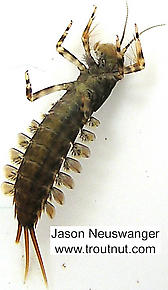 View 4 Pictures
View 4 Pictures
 View 4 Pictures
View 4 PicturesCollected February 7, 2004 from the Namekagon River in Wisconsin
Added to Troutnut.com by Troutnut on January 25, 2006
Added to Troutnut.com by Troutnut on January 25, 2006
Dicranota True Fly Larva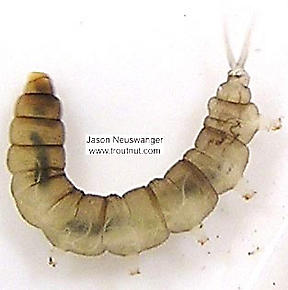 View 3 Pictures
View 3 Pictures
 View 3 Pictures
View 3 PicturesCollected February 5, 2004 from unknown in Wisconsin
Added to Troutnut.com by Troutnut on January 25, 2006
Added to Troutnut.com by Troutnut on January 25, 2006
Simuliidae (Black Flies) Black Fly Larva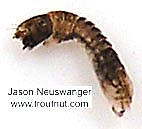 View 3 Pictures
View 3 Pictures
 View 3 Pictures
View 3 PicturesCollected February 5, 2004 from Schacte Creek in Wisconsin
Added to Troutnut.com by Troutnut on January 25, 2006
Added to Troutnut.com by Troutnut on January 25, 2006
Ephemerella subvaria (Hendrickson) Mayfly Nymph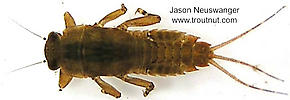 View 3 PicturesHere's another nymph with the strange brownish coloring rather than the olive I usually see for subvaria. I suspect it's the same species and it's just wide individual variation.
View 3 PicturesHere's another nymph with the strange brownish coloring rather than the olive I usually see for subvaria. I suspect it's the same species and it's just wide individual variation.
 View 3 PicturesHere's another nymph with the strange brownish coloring rather than the olive I usually see for subvaria. I suspect it's the same species and it's just wide individual variation.
View 3 PicturesHere's another nymph with the strange brownish coloring rather than the olive I usually see for subvaria. I suspect it's the same species and it's just wide individual variation.Collected February 7, 2004 from unknown in Wisconsin
Added to Troutnut.com by Troutnut on January 25, 2006
Added to Troutnut.com by Troutnut on January 25, 2006
Female Hexagenia limbata (Hex) Mayfly Dun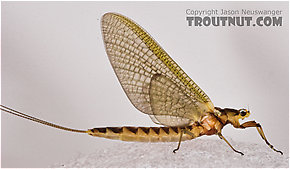 View 5 Pictures
View 5 Pictures
 View 5 Pictures
View 5 PicturesCollected June 28, 2005 from the White River in Wisconsin
Added to Troutnut.com by Troutnut on May 26, 2006
Added to Troutnut.com by Troutnut on May 26, 2006
Eurylophella (Chocolate Duns) Mayfly Nymph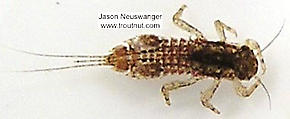 View 3 PicturesLooking at this specimen under a microscope revealed prominent sharp abdominal tubercles (
View 3 PicturesLooking at this specimen under a microscope revealed prominent sharp abdominal tubercles (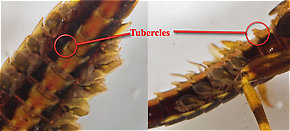 Tubercle: Various peculiar little bumps or projections on an insect. Their character is important for the identification of many kinds of insects, such as the nymphs of Ephemerellidae mayflies.). Also, abdominal segment 9 is distinctly longer than abdominal segment 8, meaning this is definitely a Eurylophella nymph.
Tubercle: Various peculiar little bumps or projections on an insect. Their character is important for the identification of many kinds of insects, such as the nymphs of Ephemerellidae mayflies.). Also, abdominal segment 9 is distinctly longer than abdominal segment 8, meaning this is definitely a Eurylophella nymph.
 View 3 PicturesLooking at this specimen under a microscope revealed prominent sharp abdominal tubercles (
View 3 PicturesLooking at this specimen under a microscope revealed prominent sharp abdominal tubercles (
A few (not all) of the abdominal tubercles on this Ephemerella needhami nymph are circled. They are especially large in this species.
Collected February 7, 2004 from unknown in Wisconsin
Added to Troutnut.com by Troutnut on January 25, 2006
Added to Troutnut.com by Troutnut on January 25, 2006
Ephemerella invaria (Sulphur Dun) Mayfly Nymph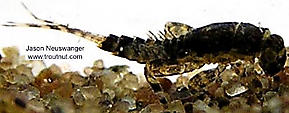 View 4 PicturesI looked at this nymph closely under a microscope to ascertain some key features I was wondering about in previous photographs of similar specimens. It definitely does have the fan-tail characteristic of the Ephemerella genus. It also has strongly 2-banded tibiae (
View 4 PicturesI looked at this nymph closely under a microscope to ascertain some key features I was wondering about in previous photographs of similar specimens. It definitely does have the fan-tail characteristic of the Ephemerella genus. It also has strongly 2-banded tibiae (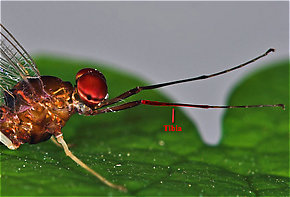 Tibia: A middle segments in the leg of an insect, located between the femur and the tarsus.) and definite tiny abdominal tubercles (
Tibia: A middle segments in the leg of an insect, located between the femur and the tarsus.) and definite tiny abdominal tubercles ( Tubercle: Various peculiar little bumps or projections on an insect. Their character is important for the identification of many kinds of insects, such as the nymphs of Ephemerellidae mayflies.).
Tubercle: Various peculiar little bumps or projections on an insect. Their character is important for the identification of many kinds of insects, such as the nymphs of Ephemerellidae mayflies.).
 View 4 PicturesI looked at this nymph closely under a microscope to ascertain some key features I was wondering about in previous photographs of similar specimens. It definitely does have the fan-tail characteristic of the Ephemerella genus. It also has strongly 2-banded tibiae (
View 4 PicturesI looked at this nymph closely under a microscope to ascertain some key features I was wondering about in previous photographs of similar specimens. It definitely does have the fan-tail characteristic of the Ephemerella genus. It also has strongly 2-banded tibiae (
The tibia of this Isonychia bicolor mayfly spinner is highlighted in red.

A few (not all) of the abdominal tubercles on this Ephemerella needhami nymph are circled. They are especially large in this species.
Collected February 7, 2004 from unknown in Wisconsin
Added to Troutnut.com by Troutnut on January 25, 2006
Added to Troutnut.com by Troutnut on January 25, 2006
Caenis (Angler's Curses) Mayfly Nymph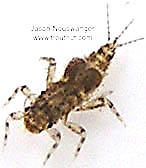 View 3 Pictures
View 3 Pictures
 View 3 Pictures
View 3 PicturesCollected February 7, 2004 from unknown in Wisconsin
Added to Troutnut.com by Troutnut on January 25, 2006
Added to Troutnut.com by Troutnut on January 25, 2006
Ephemerella subvaria (Hendrickson) Mayfly Nymph View 3 PicturesThis is another peculiar brownish Ephemerella. It has double-banded tibiae (
View 3 PicturesThis is another peculiar brownish Ephemerella. It has double-banded tibiae ( Tibia: A middle segments in the leg of an insect, located between the femur and the tarsus.) and prominent black-fringed tubercles (
Tibia: A middle segments in the leg of an insect, located between the femur and the tarsus.) and prominent black-fringed tubercles ( Tubercle: Various peculiar little bumps or projections on an insect. Their character is important for the identification of many kinds of insects, such as the nymphs of Ephemerellidae mayflies.).
Tubercle: Various peculiar little bumps or projections on an insect. Their character is important for the identification of many kinds of insects, such as the nymphs of Ephemerellidae mayflies.).
 View 3 PicturesThis is another peculiar brownish Ephemerella. It has double-banded tibiae (
View 3 PicturesThis is another peculiar brownish Ephemerella. It has double-banded tibiae (
The tibia of this Isonychia bicolor mayfly spinner is highlighted in red.

A few (not all) of the abdominal tubercles on this Ephemerella needhami nymph are circled. They are especially large in this species.
Collected February 7, 2004 from unknown in Wisconsin
Added to Troutnut.com by Troutnut on January 25, 2006
Added to Troutnut.com by Troutnut on January 25, 2006
Top 10 Fly Hatches
Top Gift Shop Designs
Eat mayflies.
Top Insect Specimens
Miscellaneous Sites
Troutnut.com is copyright © 2004-2024 Jason
Neuswanger (email Jason). See my FAQ for information about use of my images.
 privacy policy
privacy policy
